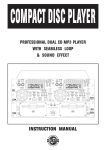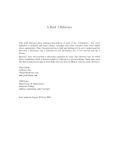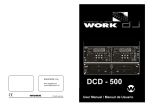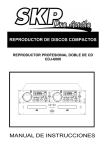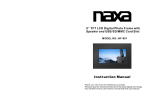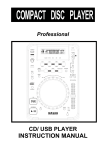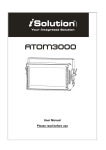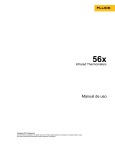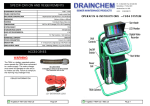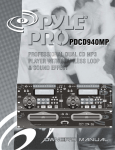Download Radio Shack PDCD810 User's Manual
Transcript
TABLE OF CONTENTS NOTE ON USE ……………………………………………………………2 FOR SAFE AND EFFICIENT OPERATION ……………………………2 DESCRIPTION OF THE FUNCTIONS …………………………………3 FUNCTION OF THE MAIN UNIT……………………………………………3 FUNCTION OF THE CONTROL UNIT………………………………………4 CONNECT IONS …… …………………… ……………………………6 BAS I C OPE RAT I ON …………… …………………… ……………7 LOADING AND EJECTING T HE DISC ……………………………………7 TRACK SKIP ……………………………………………………………8 ANTI SHOCK MEMORY……………………………………………………8 MATCHING THE BEATS PER MINUTE ……………………………………9 BEAT MATCHING USING PITCH BEND……………………………………9 OPERATION OF CUE AND LOOP ……………………………………10 BEFORE SWITCHING OFF THE POWER …………………………11 TROUBLESHOOTING GUIDE ………………………………………11 -1- NOTE ON USE BE CAREFUL OF HIGH TEMPERA- TO AVOID DUST& MOISTURE TO TURE IF OUT OF AVOID PLACING ON UN- DO NOT USE CHEMICALS STABLE LOCATION WORK, CONTACT SALES AGENCY IMMEDIATELY KEEP AWAY FROM TV & DO NOT OPEN THE CASE CARE WITH THE POWER CORD MAGNETISM For Safe and Efficient Operation • Select the installation location of your unit carefully. Avoid placing it in direct sunlight. Also avoid locations subject to vibration and excessive dust, heat, cold or moisture. Keep away from sources of hum such as transformers or motors. • Do not use this compact disc player where there are extremes in temperature ( below 41 o F/5 o C or exceeding 95 o F/35 o C ). • Do not open the cabinet as this might result in damage to the set or electrical shock. • Be sure your hands are clean when handing discs. Never insert a disc which has a crack on its surface. • When disconnecting the power cord from the AC outlet, always grasp it by the plug. Never pull the cord. • Do not use force when operating the switches and buttons. • Before moving the set, be sure to disconnect the power cord and all connecting cables. • To keep the laser pickup clean, do not forget to close the disc tray. • Do not attempt to clean the unit with chemical solvents as this might damage the finish. Use a clean, dry cloth. • Keep this manual in a safe place for future reference. SAFETY CERTIFICATION Laser Diode Properties Material: Ga.-Al-As Wavelength: 755-815 nm (25 oC) Laser Output: Continuous Wave max. 0.5mW CAUTION: USE OF CONTROLS OR ADJUSTMENTS OR PERFORMANCE OF PROCEDURES OTHER THAN THOSE SPECIFIED HEREIN MAY RESULT IN HAZARDOUS RADIATIO EXPOSURE. -2- To prevent electric shock do not remove cover (or bottom screws). No user serviceable parts inside refer servicing to qualified servicing personnel. DESCRIPTION OF THE FUNCTIONS Function of the Main Unit : 810 115 V 60 Hz 1.POWER(Power Switch) 230V 50Hz 7.CONNECTOR PORTS Press the power switch to turn the unit on. To switch the POWER off press the POWER switch again. The 8-pin termination permits the connection of the main unit to the control unit. 2.Disc Loader 8.DIGITAL OUT The disc is placed on the loader and the CD disc will be loaded automatically. Pressing the Eject button to eject the CD Disc tray. The digital from each CD player is output from these jacks. Connect to the line input of the D/A Amplifier. 9.START/PAUSE 3.Eject Button This connector is used for fader start; connect it to a mixer and remote control the “START/PAUSE” by moving the fader of mixer. Press to load or eject the disc 4.DISC illuminator 10.TACT-LOCK option To illuminate for disc. Select the type of switch in the mixer for FADERSTART wire remote control. 5.AC INPUT Connecting this power cord into an AC wall outlet with the proper AC voltage. 6.LINE OUT (Output Jacks) The audio from each CD player is output from these jacks. Connect to the line input of the mixer. -3- Function of the Control Unit 40 1. UNIT 1-CONTROL OPERATION PANEL 11. CUE BUTTON This operation panel remotely controls the main unit 1. The cue function allows the CD to be played from the memorized point any number of times. W ith the unit in the pause mode, pressing the CUE button to set up the memorized cue point and then the cue button blinks. 2. UNIT 2- CONTROL OPERATION PANEL This operation panel remotely controls the main unit 2. 3. OPEN/ CLOSE BUTTON 12. BOP BUTTON Press to load or eject the disc. Each press will open or close the disc tray. Note: Disc will not eject. Unless the stop or pause button has been push first The playback will automatically play from the CUE point upon the button is pressed. 13. PITCH BUTTON W ith unit on the PITCH ON mode, to select the pitch range from 8%, 16%, which the LED indicator flashes. To select 8 % will assign +/-8 % to pitch control slider and so does 16%. W ith the unit on the PITCH OFF mode, it means playback speed is normal (0%). The playback speed will not change when you move the pitch control slider. 4. L.C.D These liquid crystal display (L.C.D.) indicate the track numbers, time (minutes, second, frame), remain, pitch, beat, loop, auto cue single, continue and time bar. 5. CONT./SINGLE BUTTON ( OUTRO) 14. PITCH CONTROL SLIDER To press this button it can switch between auto cue single and continue. The selected mode is indicated on the display. *AUTO CUE SINGLE-After each track, the unit pauses at the beginning of next track. The playback starts from audible point. *CONTINUE—To play the whole tracks. *OUTRO-Press the button for 3 seconds for OUTRO function, the unit will play the last 30 seconds of each track . To match the choices of playback speed (8%, 16% ), you can choose what range you want between minimum (up side) and maximum (bottom side) by moving the pitch control slider. 15. PITCH BEND + / - BUTTON W hen each of the two CD players is playing, the pitch bend function allows the position of the bass beat to be matched after the pitch has been adjusted. The pitch will automatically rise up to + 16% from the current setting while pressing the “ + “button. W hile pressing the “ – “ button, the pitch will automatically drop to - 16 % from current setting. By the way of changing the pitch the position of the beats can be matched. 6. TIME / STOP BUTTON This button switches the time display between each remaining time, elapsed playing time, and total remaining time. The unit will be in the “stop ” mode if you continue to press the button for more than 3 seconds. 16. JOG WHEEL 7. SEARCH BUTTON This contains various functions, as follows: *Speed Control Pressing the button for quick forward or backward Rotating the wheel, in play mode, will change the playback speed 8. TRACK BUTTON accordingly. W hile rotating clockwise, the player speed increase; rotating counterclockwise, the speed decrease. This button selects the track to be played 9. +10 BUTTON *Searching Pressed the button to forward 10 tracks. If you forward 10 tracks, and the tracks over total tracks, the unit will jump to track 1. Rotating the wheel in pause mode, the player will forward or backward to the desired point to start. The searching speed changed according to the dialing speed. It can be carried out by 10. PLAY/ PAUSE BUTTON one frame increment. Each press of this button causes the operation to change between PLAY and PAUSE modes. -4- 17. Seamless Loop (2 set) 19. PROGRAM BUTTON You can program the track you want. W hile the unit is stopped, pressing the PROG button first to enter memorized mode, by pressing the skip buttons to select the tracks you want to order and then press the PROG button again to compete set up per track. The max tracks you can program are 30 tracks. While playing programmed tracks, the LED of PROG lights up. W hile the unit is stopped, open the tray disc or turn off the power, the program will be exited. There is A, B/LOOP/ EXIT, RELOOP buttons. 1. A BUTTON---“start point” (A point. Also, Cue 1 could be a A point) After setting up the A point, the red Led light up! 2. B/LOOP/ EXIT BUTTON: ---“ End point”(B point). Press the B /LOOP button to set up the B point and start the loop playback automatically. Loop lights on the display and the 3 LEDs flash. Press this button again to exit the LOOP 20. BPM BUTTON playback. 3. RELOOP BUTTON To get the BPM number manually. 21. Direct Access Key(0~9) Return to the loop playback by pressing the RELOOP while in performance. However, if your want to return to loop To select the number of the track you would like to play. 22. CONNECTOR PORTS playback, you can press RELOOP BUTTON. 4. Change “ START POINT” and” END POINT” by pressing The 8-pin termination permits the connection of the control unit to the main unit. the A& B/ LOOP/ EXIT button again. The interval between A and B point must be more than 20 23. SLEEP: frames; otherwise, the B point will be canceled, then LOOP function disappear and LOOP fades on the display. Leave the unit unused for 30 minutes; the machine will shut off automatically. 18. RELAY Press the “RELAY” button to activate. W hen one unit is in play mode, and the other unit is in “pause” mode; pause the playing unit, the other unit will automatically start to play. Connections Typical connections with a mixer is illustrated below. Please use it for reference. 1 5V 60 H z 230V 50Hz * Connect the connection cords to the line inputs of your mixer. * The connection cords and the remote control connection cable are supplied with the main unit. * Be sure to use the remote control connection cable which has been supplied. Use of another cable type might cause damage. -5- BASIC OPERATION Loading and Ejecting the Disc When the disc is loaded, press the EJECT button to eject the disc (T his may be done on either the player or the remote control side.) Place a disc in the disc loader 12 cm disc 8 cm disc Push the disc to the loader. While the disc is loaded, the preparation for disc play will begin. When preparation is completed, the total tracks number & total playing time will display. To the desired track -6- TRACK SKIP T o go ba ck thro ugh the track s To a dva nce throu gh the tra cks Tracks change as follows (This is for a disc containing 4 tracks) Tracks change as follows When this button is pressed once, the CD player will skip When this button is pressed once, the CD player backward to the beginning of the track, press twice will skip backward to the previous track. will advance to the beginning of the next track. ANTI SHOCK MEMORY This CD Player is equipped with an anti-shock memory, wish memorize 10 seconds of music before reading, to be not in case of shock. W arning: This system can't work in case of repetitive shocks or vibrations and if the memory is not completely charged. -7- MATCHING THE BEATS PER MINUTE Match th e pi tc h by mo ni to ri ng the mu si c of both UNIT 1 a nd UNI T 2 by e ar . W he n th e te mpo o f the musi c of the se le cted CD p la ye r is slow co mpa red to the temp o of the o ther p laye r, move th e slid er to the + sid e and ma tch the tempo . W he n fa st, mo ve to th e - si d e. Th e fo llo win g de scr i ptio n is fo r th e ca se of match in g th e pi tc h of UNI T 2 to the p itch o f the mu si c bei n g playe d on UNI T 1. Bu UNIT 1 is playing. f f e r Me m o r Press PLAY/PAUSE to start UNIT 2. Both CD players are playing discs. Listen to UNIT 2 in your headphones. Bu y f f er M e m o r When UNIT 2 is slow compared When UNIT 2 is fast compared to UNIT 1 to UNIT 1 Beat Matching Using Pitch Bend A de scr i ptio n of the p ro ced ur e fo r matc hi ng the be at o f UNIT 1 a nd UNI T 2 usi ng the PI TCH B END sti ck i s gi ve n be lo w. Th is d escr ip ti on i s f or the c ase of ma tc hi ng the b eat of UNIT 2 to the b eat of the mu si c be in g play ed on UNIT 1 . (Thi s pr oc edu re c an be d on e on ei ther Uni t). After Matching the BPM's BPM’s (Beat Per Minute) are the same, however the bass beats are not matched. When UNIT 2 is ahead. When UNIT 2 is behead. -8- y OPERATION OF CUE (WITH PLAY/PAUSE) 1. In p ause mod e, p re ss CUE b utto n to memo ri ze a p oi nt f or playi ng b ac k. W e me an i t “ cue p oi nt”. 2. After “c ue po in t” is m emor i zed , i n play mo de , pr essi ng CUE b utto n wi ll re turn th e musi c b ack to the cu e po in t and keep i t i n p ause mod e. 3. Pre ss PL AY bu tton a ga in to pe rf or m fr om “c ue p oi nt”. OPERATION OF A AND B/LOOP 1. Set “ A POI NT” un der p lay mod e by p re ssi ng A b utto n (witho ut i n te rr upti on d ur in g playb ac k) . 2. Pre ss B/ LOOP to m emor i ze the e ndi ng p oi nt o f loo p, we m ean i t “ B POI NT” . A t the mea nti me, i t b li nks LOOP o n th e LCD, and the m usi c au to mati cally co mes b ack to “ A POI NT” a nd loo ps b etwee n A & B p oi nts. 3. W h ile the mu si c loop s be tween A & B, pre ss to le ave th e lo op . At the m ean ti me , i t lig hts LOOP o n th e LCD. 4. Pre ss RE LOOP a gai n d uri n g playb ac k, i t r etur ns the loo p fu nc ti on . 5. W i thi n play i nter val, yo u can c ha nge “ A POI NT” & “ B POI NT” by p ressi ng A & B/ LOOP button u nde r play mo de. 6. Also avai lable to ch ang e “sta rt poi nt” b y pr essi ng A bu tton i n pa use mode d ur in g loop f un ctio n. 7. The i nter va l b etwee n A & B p oi nt m ust be mo re tha n 20 f ram es, or the B p oi nt will b e can ce le d, the n loop fu ncti on di sapp ear , a nd LOOP fa des on the LC D. -9- BEFORE SWITCHING OFF THE POWER When you have finished using the CD player, before switching off the power, ensure that the disc is ejected. Do not switch off the power when the disc in the loader. Switch off the power after the disc is ejected. POWER OFF POWER OFF TROUBLESHOOTING GUIDE If difficulties arise with your compact disc player, locate the apparent problem in the left-hand column of the table and follow the corrective action suggested in the right-hand column. 1. Is the compact disc player properly connected to the amplifier? 2. Is the amplifier set for the proper operation? 3. Have the operating instructions for the compact disc player been followed? Symptom The power fails to switch on when the POWER switch is set Possible Cause Corrective Action Poor power plug connection at the AC outlet. Insert the power plug firmly into the AC outlet. The disc is loaded upside down. The disc is too dirty. Reload the disc with the label side up. Clean the disc. Improper output cable connections. Connect the output cable properly. Make sure that the amplifier controls are set to ON Disc play does not start No sound Sound skips Hum Improper amplifier operation. The CD player is subject to vibrations or properly. Change the installation location. physical shock. Loose cable connections. Firmly connect all audio plugs. - 10 -











